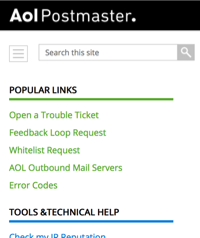New AOL Postmaster Pages
AOL has updated their Postmaster pages with a new design and new resources for senders who are sending to AOL. If you are sending to AOL, use the updated site to sign up for the feedback loop, request whitelisting, open a trouble ticket, or learn about the AOL error codes and bulk sending best practices.